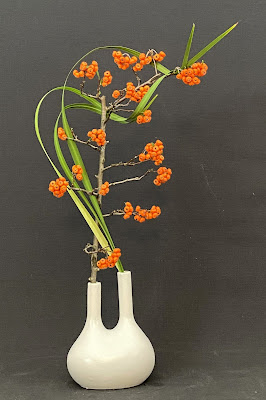 |
| Bredenia's arrangement |
Hello all,
Today's masterclass was particularly challenging for the participants, who arrived having no idea of what was expected of them. As usual, I provided materials and containers for each one but it was by lottery that it was decided who would get which materials.
I instructed them that they would each do a demonstration of their arrangement. I gave a talk about demonstrating, drawing from my rather lengthy experience. I allowed them as much time as they needed to, first of all, plan an arrangement with materials they had not seen before and to prepare it for a demonstration.
They, then, took turns to demonstrate and, I'm happy to say, they all did well. I feel it is very important to practice demonstrating Ikebana. For some people, demonstrating in front of an audience comes quite naturally but, for others, it can be daunting. The only way to get over this is to practice as much as possible, especially in the safe environment of class. Good demonstrations are very important for teaching purposes but, also, for promoting Ikebana to the general public.
Lucy's lottery number was 1 and her materials were three different types of big, strong leaves, which necessitated making an arrangement with leaves only. Her container was a large, lacquered, asymmetrical suiban, red on the inside and black on the outside. Lucy was quite inventive with the mechanics she employed.
Bredenia drew the number 2. Her materials were cotoneaster berry branches, from which she painstakingly removed all the leaves, hydrangea stems that are turning golden and two Asiatic lily stems. Her container was a tall ceramic vase.
Vicky drew the number 3. She had two monstera deliciosa leaves, wisteria vine and two stems of Asiatic lilies. Her container was a particularly strong and heavy ceramic vase with a split down the middle.
Susan was next and she had a low container with several holes at the top. She had a generous bunch of umbrella grass, enough to practice with and then to demonstrate and two stems of mauve chrysanthemums.
Akemi drew number 5. She had corky elm stems, the tips of which she snapped to create an interesting shape, chrysanthemums and amaranthus. Her vase was ceramic with splits on either side.
Christine drew number 6. She had a ceramic, nageire container, Siberian dogwood, alstroemeria psittacina leaves and 2 iris stems. She used a horizontal fixture to secure the tall, curved stems to the vase, creating a beautiful space.
And last but, by no means, least was Jenny. She had a modern, triangular, ceramic container, aspidistra leaves, wisteria and 3 iris stems. Jenny used a stick in the shape of a fork inside the container to support the very slanted iris stems.
The class ran to almost double the normal time but I had expected that it would and had warned the participants. We also had to contend with the safety requirements imposed on us due to the latest restrictions. We wore masks, There was one table per person, thus keeping the required distance between them, I have a QR code that everyone used to check in, I sanitised all the surfaces and cordoned off the house from the studio. Despite all that, we had a very pleasant and productive lesson. I look forward to more.
Bye for now,
















































